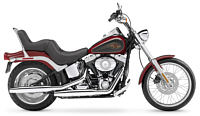|
|
|

|
Home > Tech Tips > Planning
To Build or Rebuild: The Advantages and Disadvanatges of Chopping A Stock Motorcycle
By Jason Van Wyhe
 One of the first things anyone should consider when thinking about building a chopper is if you want to chop an existing bike, or start from scratch. There are some very distint advantages to modifying an existing bike as opposed to starting with a rolling chassis or even just a frame. I'm not going to try to persuade you either way, just present the facts and let you decide what's the best for your project.
One of the first things anyone should consider when thinking about building a chopper is if you want to chop an existing bike, or start from scratch. There are some very distint advantages to modifying an existing bike as opposed to starting with a rolling chassis or even just a frame. I'm not going to try to persuade you either way, just present the facts and let you decide what's the best for your project.
The Advantages
Lower Overall Cost
You CAN save a pile of money by chopping an existing bike as opposed to building from scratch. In the 90's and turn of the millenium, this simply wasn't the case. Because of the bad economy, you can buy a stock evo for as low as $6000, or a shovelhead for $4000. That's awefully cheap when you consider a Harley crate motor alone will run $3500, or the cheapest S&S will set you back $4500. And while the frame, engine, and transmission are the obvious areas you save money, there's also huge savings available in an area few inexperienced bike builders ever think about; all the small parts. The cables, hoses, lights, horns, brake lines, calipers, and all the other little parts you need to finish off a bike nickel and dime you to death. As a general rule, I expect to have to come up with $3000 extra to finish off a bike AFTER I have all the major components. Starting with an existing bike can eliminate most of these. Titling
Getting a custom chopper can be a real pain. There are inspections, MSO's, receipts and a number of other things to worry about. If you're chopping a stock bike, you don't have any of these headaches. Your title remains the same, few state require inspections, and MSO's aren't usually required. Even if you want to switch frames, it's not a problem. If you have a bike newer than 1970 and your bike has the numbers in the neck, simply swap the neck from your old frame and put it on the new one. The title goes with the neck, not the entire frame. It's even easier if you have an old Harley Knuckle, Panhead, or Shovelhead. The title goes with the motor on these bikes - the frame numbers mean nothing. So you can change absolutely anything on these short of switch the left side motor case, and the title remains the same. Insurance
Along with titling, insurance can be a real pain on a custom chopper built from scratch. Many insurance carriers won't even touch them. The ones that do want your first born child in payment. If you're still titled as that '86 softail, you won't have any troubles. All you have to do is up your coverage levels to reflect the bikes value, and off you go. Even with additional coverage your rates will still be a fraction of the cost of a custom build. Fitment
All aftermarket parts fit perfectly. And if you believe that, I have some "prime real estate" in the Florida Everglades I want to sell you. Aftermarket parts can be maddeningly inconsistent. Frame motor mounts misaligned, gas tanks that won't fit, cables that are too short. You KNOW all the parts off an existing bike fit perfectly, and if you do need to make changes, you have an old part to bring into a dealer to compare to.
Quality
We live in a world where a lot of things are made in China, and aftermarket parts are no different. Some are pretty solid quality-wise, others are junk. OEM equipment has to go through rigorous testing for the goverment regulations, and is generally higher quality. OEM parts also have to last so they aren't constantly doing warranty work. So while that cheap chrome front brake caliper might be prettier, it probably isn't as well made as the stock one. Just something to consider.
The Disadvantages
Increased Cost
Wait a minute, I thought you said chopping a stock bike was cheaper? Well, it is if you plan on using or modifying the majority of the parts. For example, if you just want to frisco the tank, rake the neck, put a long front end on and a 200 rear tire, redo that stock bike. On the flip side, if you want a big motor, RSD, a ton of chrome junk, and a ridiculously custom frame, your costs are going to sky rocket. You are much better off building from scratch. There are many dealers that will get you great deals on rolling chassis and drive train packages, and if you're going to make wholesale component changes, that's the way to go. Get some prices, crunch a few numbers, and decide before you begin what is cheaper. The difference can be many thousands of dollars.
Limited Options
There is only so much you can do with a stock bike before you start to see diminishing returns both in terms of cost and time. If you have very specific requirements for the look and ride you want, you might be better in the long run doing what was suggested above: start with a rolling chassis and drive train package. A pile of custom parts will kill your budget really fast, and having to modify every peice of metal on it will take you years. So think a little about that before you jump in to it either way.
Resale Value
The problem with dumping money in a 1986 Softail is that when you are done, it's still a 1986 softail. It doesn't matter how nice it is, there is a ceiling to how much it is worth. The money you save on insurance and titling you lose on resale. Just a fact of life - you always pay somewhere.
So in summary, if you want a simple chopper and don't particularly care about chrome or big horsepower, chop a stock bike. If you want a crazy one-of-a-kind super chopper, start from scratch.
| DISCLAIMER
The statements and opinions expressed in articles, reviews and other materials on this website are those of the authors. They do not reflect the views of Red Dragon Publishing or any of its affiliates.
While every care has been taken in the compilation of this information and every attempt made to present up-to-date and accurate information, we cannot guarantee that inaccuracies will not occur. Red Dragron Publishing will not be held responsible for any claim, loss, damage or inconvenience caused as a result of any information within these pages or any information accessed through this site.
©2009 Red Dragon Publishing. This Article may not be reproduced without the express written consent of Red Dragon Publishing. It may not be re-posted or redistributed on another web site, or any other form of media, or under a different author's name. Feel free to print copies for your personal use, however.
|
|




 One of the first things anyone should consider when thinking about building a chopper is if you want to chop an existing bike, or start from scratch. There are some very distint advantages to modifying an existing bike as opposed to starting with a rolling chassis or even just a frame. I'm not going to try to persuade you either way, just present the facts and let you decide what's the best for your project.
One of the first things anyone should consider when thinking about building a chopper is if you want to chop an existing bike, or start from scratch. There are some very distint advantages to modifying an existing bike as opposed to starting with a rolling chassis or even just a frame. I'm not going to try to persuade you either way, just present the facts and let you decide what's the best for your project.